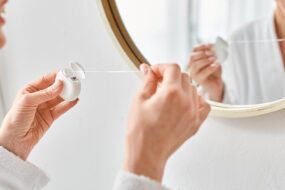What to do if you get a UTI
Most women will have at least one urinary tract infection in their lifetime. The good news is that treatment for UTIs is simple and effective.
Urinary tract infections (UTIs) are a common problem, particularly for women.
They are mostly caused by bacteria getting inside the urethra – the thin tube that takes urine out of the body – and in to the bladder which is known as cystitis.
Infections can also happen in the kidneys, which is called pyelonephritis.
Women are more likely to experience a UTI simply because of the design of their anatomy.
“The urethra is quite short and for women there isn’t much distance between that opening, the bladder and the vagina and anus,” says Dr Lara Roeske from the Royal Australian College of General Practitioners.
“Because all these are in close proximity, this increases the risk for bacteria to reach the bladder by ascending up the urethra.”
- Regular tests: 10 top health checks for women – and when to have them
What causes UTIs?
Women can be at increased risk of developing a UTI because of hormonal changes that occur during pregnancy and menopause.
During pregnancy, an expanding uterus can create pressure that further shortens the urethra and so makes it even easier to transmit bacteria.
“In post-menopausal women, the vagina becomes drier and thinner because of a fall in oestrogen,” says Dr Amanda Newman, a specialist women’s health GP from Jean Hailes for Women’s Health.
“This can lead to cracks in the skin that are open to infection. This is easily and safely treated using vaginal oestrogen. It’s a safe and effective cream or tablet that is inserted into the vagina.”
Wiping from back to front after using the toilet can pass bacteria to the opening of the bladder and sexual activity can also cause a UTI.
What are common UTI symptoms?
Common symptoms include:
- A burning sensation when you pass urine.
- Feeling like you need to go to the toilet often.
- Cloudy or strong-smelling urine
- Pain above the pubic bone or lower back
- Blood in urine
- Fevers or chills
Treatments for UTIs
If you have symptoms, see your doctor and have a urine test.
If a UTI is confirmed, your doctor will most likely recommend a short course of antibiotics.
A urinary alkalising agent available from pharmacies can ease discomfort by changing the composition of urine so it stings less.
- Fit for life: The ultimate women’s guide to staying in peak health
How to reduce your risk of getting a UTI
Some studies have explored whether cranberry juice and capsules lower the risk of developing UTIs.
A US study found both had positive effects, but Dr Roeske says more evidence is needed to see whether cranberry products have any beneficial effects on UTIs.
You can help reduce the risk of a UTI by:
- Always wiping from front to back when using the toilet.
- Drinking plenty of water to help flush out the bladder.
- Completely emptying your bladder when you go to the toilet.
- Using a good-quality lubricant during sex to avoid damage to skin in the genital area.
- Urinating after sex to flush out bacteria.
Written by Sarah Marinos





